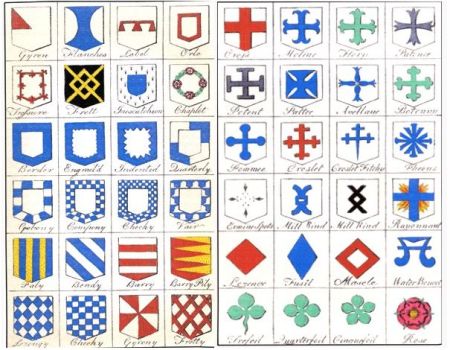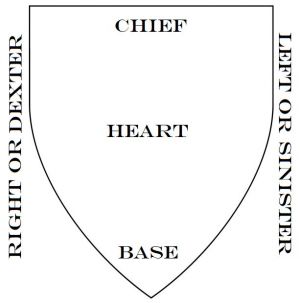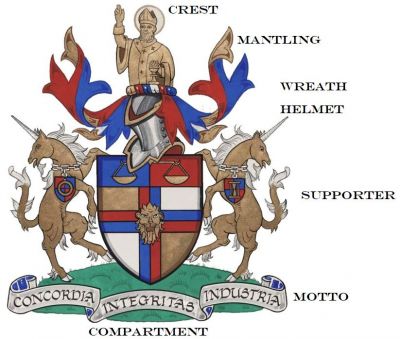Heraldic glossary
Heraldic Glossary and Compendium
This part of Heraldry of the Wold explains terminology of heraldry in different languages.
Disclaimer: This part of the site was started in November 2023 and thus is in development stage and not all heraldic terminology has yet been added, neither have most translations.
Introduction
Coats of arms (or in short 'arms') have been used since nearly 1000 years to identify a person (initially a knight), city or other entity.
Coats of arms were historically granted by rulers to persons or cities, a task often delegated to specific persons (individual heralds) or bodies (like the UK College of Arms) and recorded in armorials or registers. Already in medieval times there was a need to describe these coats of arms in words, not only in pictures. From this derived a uniform style with a specific language and terminology. This language had to be very specific as small differences and misunderstandings would lead to a different design and thus a misinterpretation. At first the design came first, but soon after the specific description (blazoning) became leading. A coat of arms was granted by a blazon mainly, and an image secondary. This is still the case in many countries, the blazon is leading. This also means that anybody can paint a coat of arms based on the blazon only. This means that different artists will draw the same arms in a really different style, which, as long as they follow the blazon, are all heraldically identical, even though they look very differently.
Many blazoning terms are quite ancient and often derived from old French. This means that a blazon often is very difficult to read for a modern individual without further heraldic knowledge, hence this glossary and index.
It is also essential to realise that a coat of arms is always described from the bearer, i.e. from behind. This means that the sides left and right are reversed for the observer. This makes the blazoning even more confusing.
The essential part is the shield, the actual coat of arms. The shield shows the colours (tinctures), divisions and the items (charges) that the owner uses to identify itself. All other things around the shield are additional to the shield and can not be displayed without the shield.
In time many additions items were placed around the shield, such as crowns, helmets, crests, supporters, compartments and mottoes or combinations thereof. Each of these also has a meaning to the owner of the arms. The total of shield and other items is called the armorial achievement. The different main parts are shown below in the arms of the National Association of Goldsmiths of Great Britain and Ireland:
Above the shield is the helmet, with on top the wreath or torse. On top of the helmet is the crest and from the helmet protective cloth falls down, the mantling. The shield is held (or supported) by two supporters and the whole stands on the compartment. The motto is placed on a ribbon over the compartment. Instead of a helmet crowns are also often used.
The above image is blazoned as follows:
- heraldic blazon: Quarterly Or and argent, on a cross quarterly gules and azure a lion's face gold; on a chief per pale of the fourth and third a pair of scales of the first.
- modern language : The shield is divided into four quarters, the first and fourth gold and the second and third silver. Over these quarters a cross has been placed, which is also divided into four quarters, of red and blue. On the cross a golden lion's face has been placed. The upper part of the shield is a separate section vertically divided in blue and red, with a golden pair of scales placed on it.
- Crest: On a wreath Or, gules, azure, argent, gules, azure, A demi figure representing St. Dunstan, nimbed, habited and mitred as a bishop, his dexter hand raised in benediction and his sinister hand resting upon a covered cup all Or. Mantled parted gules and azure, doubled Or and argent.
- On a non described helmet (!) a wreath of the colours gold, red, blue, silver, red and blue is placed with gold and blue mantling on the outside and gold and silver on the inside. From the wreath a golden bust of St. Dunstan is rising, shown as a bishop with a nimbus or halo around his head, his right hand up and his left hand on a covered cup.
- Supporters: On either side a unicorn reguardant Or, armed, crined, unguled, and gorged with a chain, argent, pendant therefrom an escutcheon quarterly gules and azure, that on the dexter charged with an annulet gold gemmed also argent and that on the sinister with an hourglass also Or.
- On either side a golden unicorn facing backwards with silver hooves, horn and pieces of fur. Each with a silver chain hanging around the neck, from which a small shield hangs, divided into four red and blue quarters, on which a golden circle is placed on the one on the left supporter and an hourglass on the right supporter.
As is clear from the above, a lot of terminology is being used. Hence the use of this glossary and index of heraldic terminology and list of charges.
Use of the glossary
The glossary can be used of course to look up individual heraldic terms or charges. As many of the arms on the Heraldry of the World site are included in the examples, it can also be used to look for a specific unknown coat of arms.
The glossary and index has thousands of terms and charges and is divided in the following sub-sections:
- Part 1 : The Shield
- Part 2 : Divisions of the Shield
- Part 3 : Ordinaries
- Part 4 : Subordinaries
- Part 5 : Heraldic or phantasy creatures
- Part 6 : Animals
- Part 7 : Humans
- Part 8 : Plants
- Part 9 : Fungi, mushrooms and other living nature
- Part 10 : Non-living nature
- Part 11 : Agriculture and fisheries
- Part 12 : Buildings
- Part 13 : Science, education and learning
- Part 14 : Food and cooking
- Part 15 : Industry, mining and tools
- Part 16 : Music and musical instruments
- Part 17 : Religious objects
- Part 18 : Royalty
- Part 19 : Sports
- Part 20 : Clothes
- Part 21 : Transport
- Part 22 : Military
- Part 23 : Archaeology
- Part 24 : Other objects
- Part 25 : Helmets and crests
- Part 26 : Supporters
- Part 27 : Mottoes
- Part 28 : Compartments and other external ornaments
- Part 29 : Terminology
- Part 30 : Rules
- Part 31 : Other aspects


